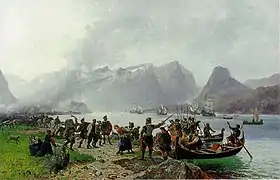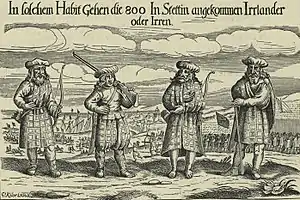George Sinclair (mercenary)
George Sinclair (c. 1580–1612) was a Scottish mercenary who fought in the Kalmar War, and was posthumously remembered in Norway[1] and the Faroe Islands through the ballad Sinklars Visa.[2][3]

Early life
George Sinclair was the illegitimate son of a Caithness laird, David Sinclair of Stirkoke, and nephew of the Earl of Caithness.[4] He was educated at Edinburgh High School and in 1595 participated in a mutiny which ended after the city officers stormed the school; according to a Norwegian source Sinclair shot a bailie with a pistol.[5]
Career

Like many of his compatriots, Sinclair sought wealth and fame serving in the armies of Europe. When James VI passed a decree in 1607 allowing his subjects to serve overseas, Sinclair raised a contingent of men from his clan.[6]
An early German basket hilt sword, the Sinclair hilt, was named after him due to the popularity of these weapons among Scottish mercenaries.[7] Many of these swords were brought back to Scotland and influenced the development of the basket-hilted claymore, a symbol of Scotland.
Death
Sinclair's forces were taken to Norway in 1612 by the pirate Robert Stewart to fight Scotland's enemies the Danes, responsible for privateering.[8] At the Battle of Kringen, Sinclair was ambushed by Norwegian militia along with 300 of his men while marching through Norway to join the army of the Swedish king Gustavus Adolphus.[9] Sinclair, riding at the head of the column and wearing a plumed helmet, was the first to fall; he was shot by Berdon Segelstad, a Norwegian militiaman. The officers, including the expedition leader, Colonel Ramsey, were ransomed while the remaining 15 survivors were conscripted into the Norwegian army.[10]
Captured Scottish weapons, including a pistol, a lochabar axe and several basket hilt claymores, were put on display at the Gudbrandsdal Museum, Kvam, to commemorate the battle.[11]
Sinclair's grave has become a popular tourist attraction. The incident was long remembered as a symbol of Norwegian resistance.
Legacy
Sinclair was immortalised in the poem "The Ballad of George Sinclair" translated into English from the original Danish/Norwegian and written by Edvard Storm, in 1781.[12][13]
Childe Sinclair and his menyie steered
Across the salt sea waves;
But at Kringellens' mountain gorge
They filled untimely graves.
They crossed the stormy waves so blue,
for Swedish gold to fight;
May burning curses on them fall
That strike not for the right!
The horned moon is gleaming red,
The waves are rolling deep;
A mermaid trolled her demon lay -
Childe Sinclair woke from sleep.
Turn round, turn round thou Scottish youth,
Or loud thy sire shall mourn;
For if thou touchest Norway's strand,
Thou never shall return.
Henrik Wergeland wrote a historical tragedy of the incident, Sinklars Død (Death of Sinclair), in about 1840. Wergeland also refers to the battle in his known poem Norges Fjelde (mountains of Norway), where he calls the lumber barricade used in the ambush a "barricade of freedom".
References
- Miller, J, Swords for Hire (2007) https://www.amazon.co.uk/Swords-Hire-Mercenary-James-Miller/dp/1841584460
- Herr Sinklar sung and danced by Havnar Dansifelag in Tórshavn, Faroe Islands (on Youtube)
- Herr Sinklar sung by people from the island of Nólsoy
- Henderson, J.Caithness family history (1884) p. 103
- - Beveridge, J., The Scottish Expedition in Norway(6 Nov 2008)
- "Sinclair genealogy". Archived from the original on 7 September 2008. Retrieved 3 November 2008.
- "Forms of European Edged Weaponry". From Simon and Schuster. Retrieved 13 November 2008.
- An Apprenticeship in Arms by Roger B. Manning (Oxford 2006)
- "Faith and War: The Battle of Kringen, 1612", Mythen der Nationen, Exhibition catalogue, German Historical Museum, 1998. Retrieved 6 November 2008.
- Clan Sinclair Timeline
- Niven Sinclair, The Battle of Kringen, 1612
- Edvard Storm, The Ballad of Sinclair, from Scottish Soldiers of Fortune by Grant (retrieved 13 November 2008)
- Øystein Rottem. "Edvard Storm". Store norske leksikon. Retrieved 1 June 2016.